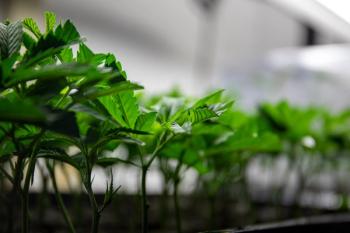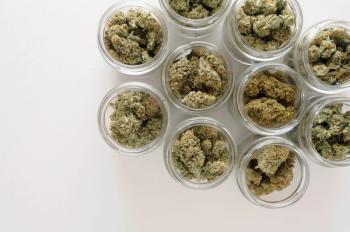
Cannabis Science and Technology
- March/April 2019
- Volume 2
- Issue 2
Cannabis for Animals: A Look Into Cannabis as Medicine for Pets
Here we review the current and pertinent literature in utilizing cannabis derivatives in animals and discuss the future forecast of cannabis in veterinary medicine.
The endocannabinoid system (ECS) has been evolving since the beginning of vertebrate species, but why did veterinary practitioners never learn about it in school? Just like our human counterparts’ veterinary practitioners have no or only a cursory understanding of the ECS and cannabis therapy. Veterinary practitioners have also been echoing that there “is no evidence” in animals. To the contrary, we have numerous studies utilizing cannabinoids and other cannabis molecules for therapeutic relief and translational studies that could be considered for any vertebrate creature. Here we review the current and pertinent literature in utilizing cannabis derivatives in animals and discuss the future forecast of cannabis in veterinary medicine.
Veterinary medicine has historically lagged behind human medicine since its inception. Veterinarians and veterinary technicians are cautious creatures that often have not only a human as the owner to deal with but a patient that cannot speak and tell you how treatment is or isn’t working. We also see less uniformity in regulations and practice acts in veterinary medicine compared to our human counterparts. What veterinary medicine and human medicine do have in common is the lack of education on the topic of cannabis as a legitimate medical therapy in veterinary school. We also see less interest in pharmaceutical companies wanting to invest in clinical studies for companion animals (cats and dogs). Moreover, we see more conservative organized veterinary medicine, like the American Veterinary Medical Association, still holding on to outdated information and prohibition era beliefs surrounding cannabis, perpetuating false assertions that there is no evidence for safety or efficacy of cannabis products in animals (1). To the contrary we have hundreds, if not thousands, of articles in laboratory animal species, which technically includes dogs and cats, verifying the safety of cannabinoids at extremely high doses and therapeutic potential for numerous conditions. Yet, the bias persists. However, the use and demand for cannabis products in veterinary medicine is growing rapidly, mainly by pet owner demand (2,3). Unfortunately, it is growing faster than most practitioners have the time to educate themselves about it. Another confounding factor feeding a negative bias in veterinary medicine is the all too often tetrahydrocannabinol (THC) toxicity in companion animals. Since the legalization of medical marijuana in the United States began, the Animal Poison Control and Pet Poison Hotline has seen a 330% increase in THC toxicities (4). There is no question to the risk and occurrence of THC toxicity in animals, yet it should be noted there are no reported deaths that can be definitively attributed to THC or other phytocannabinoids without other factoring chemicals also present in the system. The suspected lethal dose of THC in dogs is >9 g/kg, a nearly impossible dose to achieve. The most common route of exposure to THC in companion animals is via ingestion. Approximately 66% of exposures involve pets ingesting homemade or commercial edible goods. The second most common source of cannabis exposures involves ingestion of plant material, followed by cannabis oils or tinctures. Symptoms of THC toxicity include lethargy, central nervous system depression, ataxia, vomiting, urinary incontinence or dribbling, increased sensitivity to motion or sound, dilated pupils, hypersalivation, and bradycardia. Less common symptoms include aggression, agitation, low blood pressure, low respiratory rates, elevated heart rates, and nystagmus (continuous abnormal movements of the eyes). Rare signs include seizures or comatose conditions (5). A 2018 study investigating the susceptibility of cannabis-induced convulsions in rats and dogs, reported no seizures in dogs. But central nervous system signs including ataxia, tremors, and hypoactivity were observed when dogs were given chronic daily oral doses of cannabis extracts containing concentrations as high as 27 mg/kg THC combined with 25 mg/kg cannabidiol (CBD) (1.08:1 ratio of THC to CBD) for 56 weeks (6).
There are some fundamental distinctions one must make on the topic of medical cannabis, and even specific terminology used when approaching medical cannabis as a valid medical therapy. The first distinction is between a “marijuana” plant versus a “hemp” plant. The hemp plant has much lower levels of THC (less than 0.3% by dry weight) and has found favor among veterinary professionals since there is a reduced risk of THC toxicity (7). This distinction is particularly important for recommendations made by veterinary professionals. At the time this article was written there were no states that allow for medical marijuana prescriptions for veterinary use, with many states also denying veterinarians the ability to even “recommend” an over the counter hemp-based product. California was the first state to pass legislation at the end of 2018 with AB2215 that allows veterinarians to discuss cannabis as a therapeutic option, but the legislation still prohibits veterinarians from prescribing, dispensing, or recommending marijuana or hemp products to animals.
There are numerous agonists or chemical compounds extracted from marijuana and hemp plants, that act on the endocannabinoid system (ECS) in animals, just like in humans. The endocannabinoid system is an extensive group of endogenous cannabinoid receptors found in nearly every vertebrate, both centrally (in the brain) and peripherally. In fact, we see the evolution of ECS receptors in lesser species, such as invertebrates through the millennia via ancient genetic markers. This ECS is responsible for a variety of the same homeostatic processes seen in humans, with more physiological and genetic effects being discovered every year, often in research animal models. Some of these therapeutic effects, when proven in animal models, do not translate well into human models. This is likely because of the difference in the distribution and density of ECS receptors in animals versus humans (8).
Veterinary Cannabis Studies
To date, we have an ever-growing list of relevant studies for practical use of cannabis in companion animals. Most notably, we now have the results from two studies, one conducted at Colorado State University (CSU) and one from Cornell University, to help shed light on effective and safe dosing of CBD dominant cannabis products in dogs. In the Colorado State University study, conducted by Dr. Stephanie McGrath, we see dogs given three different dosing strategies. A group of 30 healthy beagle dogs were randomly assigned to receive a cannabidiol dominant product in the form of a capsule, oil, and CBD transdermal cream at a dose of 10 mg/kg/day or 20 mg/kg/day for 6 weeks. In the study, the dogs had complete blood counts, chemistry panels, urinalysis, and bile acids performed at 0, 2, 4, and 6 weeks. The most notable effect was elevations in serum alkaline phosphatase (ALP) that occurred in some dogs. All of the dogs in the study also experienced diarrhea, while the dogs that received the transdermal formula had reddened skin after application that was not of clinical concern. Because the products used in the study were plant-based, the variability between batches were measured. Variability was <10% for the CBD-infused transdermal cream and CBD-infused oil. There was considerable variation, 28–31%, between the CBD concentration in the capsules and the amount stated on the label. Higher systemic exposures were observed with the oral CBD-infused oil formulation, and the half-life after a 75 mg and 150 mg dose was 199.7 ±55.9 min and 127.5 ±-32.2 min, respectively. Exposure was dose-proportional, and the oral CBD-infused oil provided the most favorable pharmacokinetic profile. While the study mentions that the diarrhea was not related to the formula, it should be noted that this assertion cannot be made with certainty. The study concluded that this particular CBD dominant product, with no terpenes, appeared to be well tolerated in dogs (9).
Also at CSU, there are two continuing studies: one on osteoarthritis (OA) and the other on canine epilepsy. The OA study at CSU is using a 5 mg/kg daily dose for 6 weeks (the manuscript is currently under review). In the pilot epilepsy study utilizing a hemp-based product, preliminary results show eight out of nine dogs had a reduction in the frequency of seizures at 5 mg/kg once a day. A long-term study over three years will follow this study. A similar study is also being conducted at the University of Florida (10).
In a canine study conducted at Cornell University under the direction of Dr. Joseph Wakshlag, we see similar, yet more favorable results with no diarrhea, utilizing a product made by ElleVet Sciences. A single dose pharmacokinetic study was performed using two different doses of CBD enriched oil. The industrial hemp used in this study has ~10 mg/mL CBD and an equal mix of ~10 mg/mL cannabidiolic acid (CBDA), 0.24 mg/mL THC, 0.27 mg/mL cannabichromene (CBC), and 0.11 mg/mL cannabigerol (CBG). All other cannabinoids were less than 0.01 mg/mL with a robust terpene profile. The initial investigation into single-dose oral pharmacokinetics was performed with four beagles. Each dog received a 2 mg/kg and an 8 mg/kg oral dosage of CBD oil. The dogs were fed 2 h after dosing. Blood was collected at 0, 0.5, 1, 2, 4, 8, 12, and 24 h after oil administration. Pharmacokinetics demonstrated that CBD half-life of elimination median was 4.2 h (3.8–6.8 h) for the 2 mg/kg dose, and 4.2 h (3.8–4.8 h) for the 8 mg/kg dose. These results led to dosing during the clinical trial at 2 mg/kg body weight every 12 h. For the clinical efficacy study, which assessed the use for dogs with radiographically confirmed OA, a randomized placebo-controlled, veterinarian and owner blinded, cross-over study was used. Dogs received CBD oil (2 mg/kg) or placebo oil every 12 h. Hematology, serum chemistry, and physical examinations were performed on every visit. A canine brief pain inventory and Hudson activity scores showed a significant decrease in pain and an increase in activity with CBD oil. Veterinary assessment showed decreased pain during CBD treatment. Owners reported no adverse side effects; however, serum chemistry showed an increase in alkaline phosphatase (ALP) similarly to the CSU study during CBD treatment which normalized over time. Conclusions of the clinical study suggest that 2 mg/kg of ElleVet Sciences CBD product twice daily can help increase comfort and activity in dogs with OA. It should also be noted that some dogs in the study were also on traditional nonsteroidal anti-inflammatory drugs with no adverse effects (11).
Data has shown in both studies that the other nonpsychotropic cannabinoids, primarily CBD, has a wide safety margin with only minimal side effects. In both studies, the elevated ALP was notable. Interestingly, the increase in liver values was not associated with any other elevated liver values (gamma-glutamyl transferase, bile acids, or alanine aminotransferase) and may be a response to cannabinoid metabolism through the cytochrome P450 (CYP450) pathway (12,13).
Animal models of CBD utility for anxiety or panic attacks are supported by studies placing a prey species in front of a predator species and conditioned escape responses in mice and rats. According to these studies, anxiety or panic attacks would be related to the flight and freezing defensive responses elicited by threats which expression was decreased in both models (14). Canopy Growth has announced the completion of their anxiety study in companion animals that are currently awaiting publication. The author is aware of other anxiety-related research being conducted in cats and birds with hopeful publication in the next year.
Besides the alleviation of disease processes, veterinary scientists are exploring hemp for its anxiety-reducing effects and nutritional content increases in production animals. Stress on food-producing animals is directly correlated to poorer production of eggs, milk, down, wool, or muscle growth for meat producing animals. By exploring the use of naturally occurring cannabinoids in biomass from hemp production for other uses, we are beginning to see the utility for this welfare and economic challenge. The nutritional content of cannabis biomass is also being studied as feed for production animals, since seeds are particularly full of beneficial fatty acids (15–18).
Aside from pharmacokinetic, pain, seizure, and anxiety studies, we have seen scientific articles looking at cannabinoid receptor proliferation in feline and canine epidermal tissues suggesting the efficacy of topical and systemic applications for atopic dermatitis in dogs and hypersensitivity dermatitis in cats (19,20).
Other studies looking at ECS distribution in various tissues are those interested in gastrointestinal function. One study published by Glaiazzo and colleagues looked at CB1, CB2, GPR55, and PPARa in canine gastrointestinal tissue, giving us deeper insight to the anatomical basis of supporting therapeutic cannabis in relieving motility disorders and visceral hypersensitivity in canine acute or chronic enteropathies (21). We have also seen studies looking at protective effects, specifically for gastrointestinal mucosal lesions secondary to acute pancreatitis in rat models. This is of particular interest in companion animals because pancreatitis is a common occurrence (22).
Anticancer effects are one of the more common interests with owners. The scientific literature (in rodent models) is promising in several different cancer types, and certainly for the alleviation of symptoms related to chemotherapy or radiation therapy (23,24). A canine cancer study at the University of Florida has some exciting preliminary in-vitro results for three different types of canine cancer cells. Hopefully, we will see similar results in the on-going in-vivo study.
Conclusion
While the legal status of cannabis products continues to play out, it is critical that we continue to push for quality scientific data to support therapeutic evidence. Just like in human medical cannabis circles, the veterinary side of things will continue to evolve, looking for specific cannabinoid and terpene profiles for various ailments or ECS support. As scientists, consumers, and animal lovers, we must pressure cannabis manufacturers to produce products following good manufacturing guidelines, use safe ingredients for animals, and be transparent with what is in their products. To that end, manufacturers should suggest dosing regiments based on science instead of anecdotes. We must also pressure local governments, mainly state veterinary and pharmacy boards, to adopt legislative language to allow veterinary professionals to discuss, recommend, and, in some cases, prescribe cannabis product for our pets. Lastly, we must encourage the veterinary profession to educate themselves on this topic.
References:
- S. Rumple, Trends Magazine, American Animal Hospital Association, 29–34 (2018).
- L. Landa, A. Sulcova, and P. Gbelec, Veterinarni Medicina, 61(3), 111–122 (2016).
- L.R. Kogan, P.W. Hellyer, and N.G. Robinson, Journal of the American Holistic Veterinary Medical Association, 42(Spring), 40–48 (2016).
- S.D. Meola, C.C. Tearney, S.A. Haas, et. al., Journal of Veterinary Emergency and Critical Care, 22(6), 690-696, (2012).
- A. Brutlag and H. Hommerding, Vet Clin Small Anim, Toxicology of Marijuana, Synthetic Cannabinoids, and Cannabidiol in Dogs and Cats 8, 1087–1102 (2018).
- B.J. Whalley, H. Lin, L. Bell, et. al., Brit. J. of Pharm doi:10.1111/bph.14165 (2018).
- A. Greb and B. Puschner, Toxicol Commun. 2, 10–4 (2018).
- V.D. Marzo, M. Bifulco, and L.D. Petrocellis, Nat. Rev. Drug Discov. 3, 771–84 (2004).
- L.R. Bartner, S. McGrath, S. Rao, et. al., The Canadian Journal of Veterinary Research 82, 178–183 (2018).
- Coloradostate.edu, “Preliminary data from CBD clinical trials ‘promising’,”
https://cvmbs.source.colostate.edu/preliminary-data-from-cbd-clinical-trials-promising/ . Accessed 2/2019. - L.J. Gamble, J.M. Boesch, C.W.Frye, et. al. “Frontiers in Veterinary Science, Pharmacokinetics, Safety, and Clinical Efficacy of Cannabidiol Treatment in Osteoarthritic Dogs,” published online (2018): doi: 10.3389/fvets.2018.00165
- D.J. Harvey, E. Samara, and R. Mechoulam, Pharmacol. Biochem. Behav. 40, 523–32 (1991).
- S. Narimatsu, K. Watanabe, T. Matsunaga, et. al. Chem. Pharm. Bull. 38, 1365–8 (1990).
- V.P. Soared and A.C. Campos, Current Neuropharmacology 15, 291–299 (2017).
- U. Kriese, E. Schumann, W.E. Weber, et. al. Euphytica 137, 339–351 (2004).
- M. Neijat, N. Gakhar, J. Neufeld and J.D. House, Poultry Science 93, 2827–2840, (2014).
- M. Neijat, M. Suh, J. Neufeld, and J.D. House, Lipids 51, 601–614 (2016).
- O. Stastnik, F. Karasek, H. Stenclova, et. al.“The effect of Hemp By-products Feeding on Gut Microbiota and Growth of Broiler Chickens,” Conference: International Ph.D. Students Conference on MendelNet, at Fac Agron, Brno, Czech Republic, Volume 23 (2016).
- L. Campora, V. Miragliotta, E. Ricci, et. al. AJVR 73(7), 988–95 (2012).
- V. Miragliotta, P.L. Ricci, F. Albanese, et. al., Vet. Dermatol. doi: 10.1111/vde.12658, (2018).
- G. Galiazzo, F. Giancola, A. Stanzani, et. al. Histochemistry and Cell Biology, published online,
https://doi.org/10.1007/s00418-018-1684-7 (2018). - M. Cao, Y. Li, J. Xu, et. al., PLOS ONE. 12(7), e52921 (2012).
- Cancer.gov, Antitumor Effects.
https://www.cancer.gov/about-cancer/treatment/cam/hp/cannabis-pdq#_7 . Accessed 2/2019. - M. Honarmand, F. Namazi, A. Mohammadi, and S. Nazifi, J. Comp. Clinical Path published online,
https://doorg/10.1007/s00580-018-2810-6 (2018)
Stephen Cital, RVT, SRA, RLAT, VCC, VTS-LAM (Res. Anesthesia) is the co-founder of the Veterinary Cannabis Academy and consultant and research librarian for Veterinary Cannabis Education and Consulting in Wheat Ridge, Colorado. Direct correspondence to:
How to Cite This Article
S Cital, Cannabis Science and Technology 2(2), 56-60 (2019).
Articles in this issue
over 6 years ago
Making Sense of Cannabis Strains Through Chemometrics in Reviewover 6 years ago
Hemp Science Takes Root at Morgan State Universityover 6 years ago
Cultivating with LEDs: Past, Present, and FutureNewsletter
Unlock the latest breakthroughs in cannabis science—subscribe now to get expert insights, research, and industry updates delivered to your inbox.




